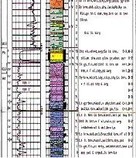
Visual Rock Characterization
Information extracted from visual analysis of rock samples focuses us on the fundamentals of oil and gas exploration and development. These data can be found in the millions of boxes of existing cores and cuttings as well as during drilling at the wellsite. A significant amount of information can be extracted from cuttings, even those chewed up by a PDC bit. Cuttings and core description brings out details of reservoir pore systems, depositional environments, facies description, supplements and enhances modern wireline logs, aids in recognizing by-passed pays, etc. Quantitative description has progressed from thin sections to enhanced imaging techniques. There is still a role for cuttings and core description in this changing technological environment. Grain size, framework, fossils, color and texture distinguish subtle facies changes, subsidence patterns, and regional structures
Rock description provides a tool to calibrate wireline logs to the rocks for quality assurance, better interpretation and even an early calibration to geophysical properties. The character of the matrix and the accessory minerals in the rock affect wireline logs, e.g. pyrite or sylvite, decreasing the uncertainty in wireline log calculations. Shows from samples and cores can be seen to exist in the rock highlighting potential pay zones.
Diagenetic changes within the rock are visible in cores as well as cuttings; these changes both create and destroy porosity. The nature and amount of porosity can be qualitatively described, including, not only pore types, but also pore distribution, and the type and amount of cement. The recognition of multiple pore types has resulted in identifying overlooked pay zones as the finest pores have higher adsorbed water percentage and larger pores will flow hydrocarbons. When dealing with unconventional reservoirs mineralogy and hardness correlate to brittleness, and fractures and microfractures are clearly evident.
Practical applications of concepts and methods for characterizing rocks are demonstrated through exercises to reinforce key concepts. Participants are expected to independently view and describe a sequence of samples for the final exercise.
Completion of the course should prepare participants for immediate application and utilization of all concepts and techniques for extracting the maximum information from cuttings and cores.
Who should attend:
Geologists in both exploration and production who desire to enhance their ability to get more information from existing sample datasets and describe lithology from cuttings and cores for stratigraphic interpretation, facies mapping and reservoir characterization.
The course is also available as a 2 Day Clastics Course or a 3 Day Carbonates Course.
- Principals of cuttings and core examination with the binocular microscope, including rock characterization and wireline log response.
- Sandstone, sandstone components, porosity and other physical characteristics.
- Siltstone and Shale
- Carbonate classification, limestone and dolomite characteristics and diagenesis
- Fossils and Rock Builders
- Evaporites and other miscellaneous rock typesLogging exercises
Presented in partnership with:
Canadian Stratigraphic Services (2000) Ltd
Phone: +1 (403) 284-1112
Fax: +1 (403) 284-1115
E-mail: info@canstrat.com



